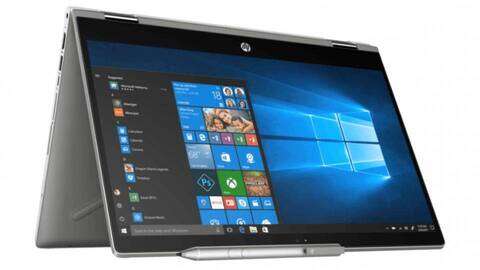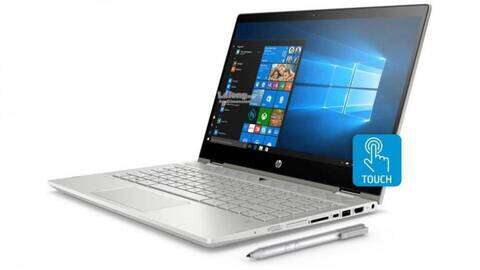HP Pavilion x360 review: Fancy a MacBook lookalike for half the price?
On unboxing the HP Pavilion x360, I briefly worried that I’d been sent the wrong machine – because this two-in-one laptop looks like it ought to cost much more than £699. Although it’s encased in low-cost grey and silver plastic, the tasteful choice of colour and texture lend it an uncanny resemblance to a £1,500 Apple MacBook.
READ NEXT: Lenovo ThinkPad X1 Yoga review
HP Pavilion x360 review: Features
It also looks a lot slimmer than the spec sheet would suggest, thanks to the clever deployment of curves and angles around the casing, and when you open it up, the two-tone hinge design cleverly de-emphasises how chunky the bezel below the screen is. In fact, when you fold the lid around to switch the x360 into tablet mode, you’ll be glad it isn’t any smaller: the bezel becomes a grip area for your hand, enabling you to hold the thing clipboard-style without accidentally triggering the touchscreen.
The display itself has an excellent contrast ratio of 1,279:1, and it’s a decent size too, measuring 14in across the diagonal. With a Full HD resolution, that translates to a pleasingly crisp pixel density of 162ppi. It’s not quite as impeccably smooth as the 227ppi screen on Microsoft’s Surface Pro 6, but you certainly won’t be complaining about blocky text.
For those who chiefly want a traditional laptop, the Pavilion x360 works very well in that orientation, too. None of the laptops this month have terrible keyboards, but the HP’s is definitely my favourite. It feels both spacious and solid, with plenty of space between the keys and a firm backplate, and almost all keys are full-sized, including the navigation keys on the right. I wouldn’t mind if the touchpad were a little taller, but it’s a good width and perfectly responsive, and there’s a fingerprint reader cleverly tucked away on the right-hand edge of the laptop.

Connectivity options are similarly practical. A full-sized HDMI connector, SD card slot and twin SuperSpeed USB 3 Type-A sockets make it a breeze to hook up whatever peripherals you like, while a USB-C port provides future-proofing.
Buy now from HP
HP Pavilion x360 review: Performance
Inside, the Intel Core i5-8520U isn’t the most powerful CPU on the market, but unless you have specific professional workloads in mind, its four cores will romp through whatever applications you throw at them. Similarly, the Intel UHD Graphics 620 GPU won’t dazzle dedicated gamers, but it can still deliver an engaging 3D experience, as its average of 45fps in the GFXBench Manhattan benchmark indicates.
Supporting the CPU, you get 8GB of RAM and 256GB of storage, which we would say is exactly the right spec for a machine like this. Unlike Acer and Dell, HP uses a fast NVMe SSD, delivering strong sequential read and write speeds of 1,252MB/sec and 731MB/sec respectively, which helps things feel responsive.
So, is this the perfect mid-price laptop? Well, not quite. The excellent contrast ratio of the screen conceals that fact that it’s oddly lacking in brightness: I measured it peaking at 196cd/m2, the lowest score of any device this month. It looks good indoors, but when bright sunlight reflects off that glossy screen it can be hard to read. Colour performance is poor as well, with only 61% sRGB coverage. That means that while photos and movies look all right, you won’t be seeing them exactly as the creator intended. The sound from the B&O speakers is slightly tinny, but they make up for that with volume.
READ NEXT: Best laptop cooling pads
Another potential annoyance is fan noise. The Pavilion x360 is perfectly quiet in everyday desktop use, but even a moderate workload – such as installing Windows updates – causes the fan to rev up audibly, and once our benchmarks got going it sounded like a tiny hairdryer. Even then, thermal throttling isn’t completely banished, as the Pavilion x360 lagged behind the Asus VivoBook X512UA in our benchmarks, even though they use the same CPU.
Finally, I have to mention battery life. The x360 gave us 6hrs 11mins of video playback on a full charge, and that’s not awful – but if you want a laptop that will run from dawn to dusk, I’d recommend you look at the Asus Vivobook S432F or the Microsoft Surface Pro 6 instead, both of which delivered upwards of nine hours. And while we’re on portability, both options are also lighter than the HP, which weighs in at 1.61kg.
HP Pavilion x360 review: Verdict
Even so, this is a laptop that I’d be happy to sit and work at all day. If you need colour-accurate visuals or silent running, look elsewhere, but the x360 gets more or less everything else right, at a price that undercuts most rivals– and the ability to flip the screen into tablet mode is a great bonus.
Buy now from HP
